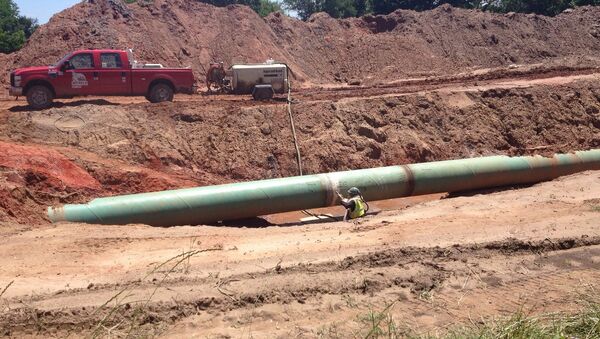Robynn Tysver, a spokesperson for TransCanada, which operates the Keystone Pipeline, has updated the company's account of the spill. Tysver told Aberdeen American News that the original estimate of 5,000 barrels was incorrect. In fact, some 407,400 gallons of crude contaminated the earth, nearly 9,700 barrels' worth.
Attorney Chase Iron Eyes of the Standing Rock Sioux Tribe, who helped lead the demonstration at Standing Rock in North Dakota against the Dakota Access Pipeline in 2016 and 2017, spoke with Sputnik about the spill in South Dakota. "I think the corporate oil industry has a big lobby at work and that includes, pretty much, domination of the mainstream media narratives," Iron Eyes said. "And so, maybe they knew they were underestimating [the spill], but it also shows that you don't know, really, the impacts; the full impacts they have perpetrated on the Great Sioux Nation's treaty rights to groundwater."
Keystone resumed operations 12 days after the spill, which preliminary reports indicate was caused by damage the pipeline sustained during construction.
Iron Eyes said that not enough was done to ensure a similar spill would not occur with the Dakota Access Pipeline, built by Energy Transfer Partners. "I don't feel that proper legal safeguards were taken," he said. Iron Eyes said that when President Trump took office, he unethically directed the secretary of the Army to "to sign the permit for the Energy Transfer Partners to drill underneath our riverbed — the title to which still rests with us."
The leak cost TransCanada $9.57 million, according to the most recent report from the federal Pipeline and Hazardous Materials Safety Administration. Their next report is due after the Department of Environment and Natural Resources updates and verifies its data from TransCanada.
"The remediation work on the property has been completed. We have replaced the last of the topsoil and have seeded the impacted area," Tysver told Aberdeen American News on April 6.
"We don't know what happened to the groundwater as a result of the Keystone oil spill… anybody who relies on groundwater there could be drinking carcinogens and other toxic substances. It represents an ongoing fight for us," Iron Eyes told Sputnik.
The battle against big oil is a familiar fight for Native Americans, according to Iron Eyes. "That's what's going on here at currently at Standing Rock because of the existence of the Dakota Access Pipeline, representing the ongoing trespass. There's a treaty violation that occurred here," he said, adding that "there should be some redress force because ones suffering at the hands of a big oil, or what we saw during the Dakota Access Pipeline — kind of a corporate, militarized response that tried to affect the narrative that native people are unruly or that the protest was… just anti-oil, that they were not environmentalists but terrorists, and so forth."
The spill is the seventh largest onshore spill of petroleum products since 2010 in the US, according the the US Department of Transportation.
"We pretend to be a nation of laws but we look the other way, and this time, you know some of these forces were able to manipulate local politics and divisions in order to create a boogeyman and spend $38 million fighting what they called violent protesters," Iron Eyes told Sputnik, in regards to the battle against the Dakota Access Pipeline, which saw five oil spills in less than one year of it being operational. "The ‘protesters' were always unarmed and peaceful and stood pursuant to their convictions and commitment to nonviolent civil resistance."
The Keystone Pipeline spans 2,600 miles from Alberta, Canada, to the midwestern United States. The Dakota Access Pipeline spans four states, reaching from North Dakota to Illinois.





